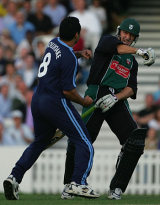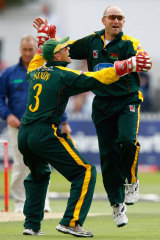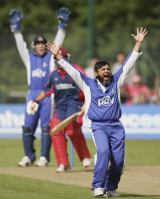The godsent gimmick
Scepticism and cynicism greeted the 2003 launch of Twenty20 and that was just from the players. Paul Weaver explains how the game's shortest form has evolved, developing skills and tactics all of its own
|
|

|
The beginnings
As domestic cricket prepares for its fifth Twenty20 Cup, the game's administrators, a notoriously hard-of-thinking lot, can pump each other's hands and congratulate themselves on their perspicacity. Faced with the ancient argument of utilitarianism - do you give people what they want or what they would want if they were better informed - the governing bodies, with no little condescension, have generally opted for the latter. Twenty20 cricket is a belated acknowledgement that, for most people, there is life beyond the game, albeit such trifling matters as spouses, children, home and work. Three-hour cricket, like most other sports, fits in with hectic, hectoring schedules.They might mess it up, of course, those governing bodies, because they often do. In 2004, the second year of the competition, they introduced quarter-finals; the following year, the first sign of real greed, they decided that each county would play eight preliminary games, instead of five, so suddenly there were 72 qualifying games instead of 45. Further expansion is planned as those pumping hands rub together, avariciously. The whole thing may be ruined but for now Twenty20 must stand as a whiz of an idea, one of the best since they played with curved bats in tall hats and decided to add a third stump (even though the finals day, the longest day in cricket, has made a bloated mockery of the whole concept).
Tom Harrison, then marketing manager at the ECB, hailed Twenty20 cricket as a "global phenomenon" after three seasons of the competition. "It has been taken up by most of the cricket-playing world and the response has been dramatic," he said. Recently John Perera, the ECB's commercial director, told The Wisden Cricketer: "Twenty20 cricket has become recognised as a form of cricket in its own right with the first world championship being staged in South Africa in September. In England it goes from strength to strength with full-house signs up for the county competition during the summer." And he is right.
Twenty20 cricket was launched in 2003 against a background of falling attendances for county matches, a malaise that 40 years earlier had given birth to the Gillette Cup, the domestic game's original one-day competition. The idea of a shorter form of the game was discussed in 1998 but abandoned. It was resurrected in 2001. More than 30 focus groups were mobilised. Then 4,000, 15-minute, face-to-face interviews were set up to gauge the public appetite for the game.
Stuart Robertson, another former ECB marketing manager and the man popularly credited with inventing the professional concept, says: "There had been a great deal of market research by the time, in April 2002, the First Class Forum voted 11-7 in favour of the experiment. Cricket in this country is often associated with white, middle-class, middle-aged males. But our research showed that, if we took those people away, and the people who really disliked the game, there was this vast number of cricket 'tolerators'. I'm talking about women, children and young men aged between 16 and 34."
These 'tolerators', according to consumer research, would welcome a short game in early evening, after school and after work. The target, to double the 1,200 crowds who attended B&H Cup matches, proved to be conservative. In July 2003, on Friday the 13th, the Twenty20 Cup was launched. Fine weather blessed it and crowds averaged just under 5,000. The following year they went up by 1,000 despite the rain and by now excited officials were lobbying for the game to be included in the 2012 Olympics. At Lord's, for the Middlesex-Surrey game, there were 27,500, the biggest for a county game (excluding cup finals) there since 1953. Despite the increase in the number of matches attendances continued to grow and last year more than half a million spectators watched Twenty20 cricket, with an average crowd of 7,000 per game.
|
|

|
The evolution
So how has the game itself changed? Adam Hollioake was the first player to master the new format. The leading wicket-taker in the first two summers, he was also a cudgelling middle-order batsman and a thinking-on-feet captain who led Surrey to victory in the fi rst season and to the runners-up spot in the second. Speaking from Perth, where he was considering the idea of a comeback with Essex this season, England's former one-day captain says: "Luck is involved in this game. It helps if the sun and the moon are in the right places. But we had a definite strategy and we stuck to it. We targeted short boundaries and tried to hit sixes. When we bowled, instead of going for yorkers and containment as some counties did, we tried to take wickets. It came off but it helped that we had some bloody good players."Jeremy Snape, captain of the holders Leicestershire - who, like Surrey, have reached every finals day, winning twice - says: "When the game was first talked about in dressing rooms in preseason 2003 it wasn't taken very seriously. But I had come from Gloucestershire, where we were always well prepared for one-day cricket. There was clarity in what players were trying to achieve in various positions. There we had the building blocks of a successful team and I was determined to bring those aspects to the new game here. Our plan hasn't changed in the four years. But the game has.
"Totals of 200 are within reach now and it has had a knock-on effect in other one-day cricket, where records have been broken. Years ago, if the rate got above six an over, everyone in the dressing room would start sweating. Now the figure is eight or nine before people start twitching to the same extent."
At The Oval these days it is the Butchers, coach Alan and captain Mark, who rule in Hollioake's place. The evolution and changes that Twenty20 has thrown up have surprised the coach: "Our thinking about Twenty20 is so different now. We thought spinners wouldn't play much part because they would see the ball disappearing but some of the most successful bowlers, both in terms of taking wickets and economy, have been slow bowlers, like Nayan Doshi. Taking the pace off the ball has been vital."
Butcher also discovered that pure quality is more important than muscle and athleticism - good basic technique is still vital: "People said it would be a young man's game. And a slogger's game. But as the scores have gone up it has been the better, more experienced players, with genuine shots, who have stood out. Twenty overs is longer than many people thought and the experienced players have been better at chasing down big scores, about seeing the end game and keeping their side in the contest right down to the death. I know Ali Brown and James Benning have their moments but look at the success enjoyed by Mark Ramprakash and Mark Butcher, hardly big-hitting players. One of the best innings played against us last year was Ravi Bopara's and there was no slogging involved, just quality batting. [He scored 83 from 46 balls hitting 10 fours and two sixes.] What you must do is have a game plan, to hit to your strengths, pick your areas and have a strategy for each bowler and every situation."
Because of the difficulty in sustaining yorkers over 20 overs Butcher tells his bowlers to hit the pitch and aim for the top of off stump - nothing too different from Championship tactics. "We start off bowling length and looking for wickets. Then, if people start getting hold of it, we bring in the yorkers, slower balls and spinners."
|
|

|
The skills
Mark Robinson, coach of last season's double winners Sussex, a county more readily associated with success in longer forms of the game, agrees with Butcher: "Twenty20 has proved to be not a young man's game but a good cricketers' game. OK, you've got to have the enthusiasm to throw yourself around. But it's more than that. It's about players with high, multi-dimensional skills. Mushy [Mushtaq Ahmed] has been one of the best bowlers in the competition and he's nearly 37." In fact, Mushtaq is the only bowler featured in the top-20 for economy rates every season.Robinson continues: "The pinch-hitters, low-order batsmen sent in early, haven't worked. The best batsmen have been top-order players who can also hit the ball sweetly. You need good strikers with good techniques because you still have to cope with Darren Gough running in. We've suffered because apart from Matt Prior we haven't had a natural striker at the top of the order. Twenty20 has been everything people wanted it to be. But I would still love it to be a pure knock-out competition."
Snape, with his masters degree in psychology from Loughborough University, also feels it is a thinking player's game. "We have this huge amount of technical input but the most fundamental things we've got as players are our co-ordination and creativity and Twenty20 allows us to explore our talents.
"It's cricket's clearest example of the chemistry between a cricketer's thinking and execution. This is a game of cat and mouse. Every ball is an event. Technique is important but we can't be boxed in by it because creativity is so important. My best ball in Twenty20 is the opposite to what the batsman's expecting. I stress to our bowlers to read the game from his side. I will bowl a little seamer, or one really wide of off stump if I think he's looking to sweep. Or a low full-toss. We've got guys running in off a shorter run-up, or not using their front arms when they deliver, just to make the batsman alter his strategy and lose the commitment to his shot. If you can consistently bowl block-hole deliveries it's a great talent but not many people have it. Besides, batsmen have learned to pull the front leg out of the way and hit through midwicket. It's subtleties and variations that are important, slower balls, surprise balls mixed in with the traditional block-hole delivery. The game has enhanced our skills." It has also moved a long way from that initial practice match.
Paul Weaver writes on cricket for The Guardian
This article was first published in the July issue of The Wisden Cricketer.
Click here for further details.
